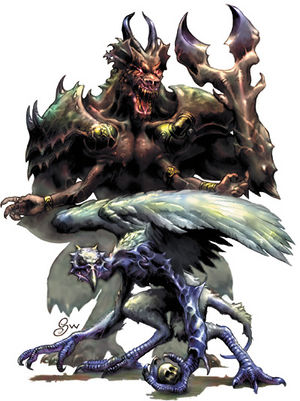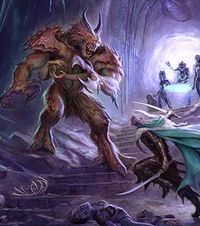On November 27th, 2022, the 8,000th article was added to the SuccuWiki!
Glabrezu: Difference between revisions
m (→Other media) |
|||
| Line 68: | Line 68: | ||
==Other media== | ==Other media== | ||
The glabrezu appears in the D&D Miniatures: Giants of Legend set (2004). | The glabrezu appears in the D&D Miniatures: Giants of Legend set (2004). | ||
== Statistics == | |||
==References== | ==References== | ||
Revision as of 10:50, 12 August 2009
This entry is in the SuccuWiki for the sake of completeness with the Dungeons and Dragons universe.

In the Dungeons & Dragons fantasy role-playing game, the glabrezu is one of the most powerful types of demon. In first edition Advanced Dungeons & Dragons, glabrezu were known as type III demons. From second edition AD&D, the name "type III demon" was revised to "glabrezu".
Publication history
The glabrezu was one of the earliest creatures introduced in the D&D game.
Dungeons & Dragons (1974-1976)
The type III demon appeared under the demon entry in the Eldritch Wizardry supplement (1976).[1]
Advanced Dungeons & Dragons 1st edition (1977-1988)
The type III demon (glabrezu) appears in the first edition Monster Manual (1977).[2]
Dungeons & Dragons (1977-1999)
This edition of the D&D game included its own version of the type III demon, which is known as the howling demon, first appearing in the Immortal Rules set, in the DM's Guide to Immortals (1986).[3] The howling lesser fiend appeared in the Wrath of the Immortals set, in "Book One: Codex of the Immortals" (1992).[4]
Advanced Dungeons & Dragons 2nd edition (1989-1999)
In this edition, demons became known as tanar'ri, and this creature officially became known as the glabrezu, a "true tanar'ri", appearing first in the Monstrous Compendium Volume Outer Planes Appendix (1991), and then reprinted in the Monstrous Manual (1993).[5]
The glabrezu true tanar'ri also appeared for the Planescape campaign setting in the first Planescape Monstrous Compendium Appendix (1994).[6]
Dungeons & Dragons 3.0 edition (2000-2002)
The glabrezu (tanar'ri) appears in the Monster Manual for this edition (2000);[7] in this edition, the name demon is resumed, and tanar'ri are now considered a sub-type of demon.
Dungeons & Dragons 3.5 edition (2003-2007)
The glabrezu appears in the revised Monster Manual for this edition (2003).
Dungeons & Dragons 4th edition (2008-)
The glabrezu appears in the Monster Manual for this edition (2008), again under the demon entry.[8]
Nature
Glabrezu tempt their victims into ruin by luring them with power or wealth. These demons are as tall as giants, with broad, muscular bodies. Two of its four arms end in clawed hands and two end in powerful pincers. Its doglike head is horned and its muzzle is full of sharp teeth. Glabrezus rank second behind the succubus in terms of demons that tempt and corrupt mortals. Unlike them, the glabrezu does not offer pleasures of the flesh but offers power, wealth, and respect undreamed of by even the most ambitious person. Strangely, glabrezus are unable to change (or polymorph) their frightening appearance, so they usually visit mortals in secret. They are most commonly summoned directly by a mortal (such as ambitious human wizards or drow priestesses) who hopes to make bargain. Sometimes they find a potential victim on their own, presenting their "gift" to this person whether or not they want it. In some cases, glabrezus never reveal themselves to a person, relying on their telepathy to speak directly in the victim's mind. They may be direct about their nature or make the person believe he is going insane.
The unholy union between an ascending high priestess of the drow goddess Lolth and a glabrezu results in a draegloth.
Known Glabrezus
- Belshazu[9]: Summoned by Triel Baenre, and coupled with her so that Triel bore the demon's seed, and produced a half-drow/half-demon child, Jeggred the draegloth. When Belshazu and Jeggred later confronted, there was no fatherly recognition between, and the former taunted the latter. Jeggred would have attacked were it not for his masters' command. Belshazu was finally killed (possibly permanently) by Pharaun Mizzyrm, while on the plane of infinite portals. He was utterly destroyed by a combination of spells ending in a high-level casting of banshee wail.
- G'oud'neejh[10]
- Mizferac[11]: A glabrezu summoned by the goodly priest Cadderly for information concern Crenshinibon. For threatening to harm the cleric's children, Cadderly dispelled the ward surrounding Mizferac's summon circle, killed the demon, and summoned it back the next day.
- Bizmatec[12] :A glabrezu summoned by Errtu the balor for the purpose of dealing with Drizzt, and was later killed by Catti-brie.
- Nabthatoron[13]: This glabrezu and his retinue were a part of an invasion force defeated at Redgorge by Surabar Spellmason and his allies. Held responsible by an unknown demon lord, Nabthatoron was banished to the prime material plane for as long as Redgorge remained unconquered. He remains as lord of the Demonskar.
- Sinmaker[14]
- Tanetal
[15]: Bane's servant, residing in then sleeping Moander's body in the astral plane.
- Ykkandri[16]
Other media
The glabrezu appears in the D&D Miniatures: Giants of Legend set (2004).
Statistics
References
- ↑ Gygax, Gary; Blume, Brian (1976), Eldritch Wizardry (1 ed.), TSR
- ↑ Gygax, Gary. Monster Manual (TSR, 1977)
- ↑ Mentzer, Frank. Dungeons & Dragons Set 5: Immortal Rules (TSR, 1986)
- ↑ Allston, Aaron. Wrath of the Immortals (TSR, 1992)
- ↑ Stewart, Doug, ed. Monstrous Manual (TSR, 1993)
- ↑ Varney, Allen, ed. Planescape Monstrous Compendium Appendix (TSR, 1994)
- ↑ Cook, Monte, Jonathan Tweet, and Skip Williams. Monster Manual (Wizards of the Coast, 2000)
- ↑ Mearls, Mike, Stephen Schubert, and James Wyatt. Monster Manual (Wizards of the Coast, 2008)
- ↑ Philip Athans (2005). War of the Spider Queen Book V: Annihilation. Wizard of the Coast. ISBN 0-7869-3752-1.
- ↑ In the Abyss p18.
- ↑ R. A. Salvatore (2000). Servant of the Shard. Wizard of the Coast. ISBN 0-7869-1657-5.
- ↑ R. A. Salvatore (1997). Passage to Dawn. Wizard of the Coast. ISBN 0-7869-0750-9.
- ↑ Jesse Decker et al. (2005). Shackled City Adventure Path. Paizo Publishing, LLC. ISBN 0-9770071-0-3.
- ↑ Jeff Grubb (2001). Manual of the Planes. Wizard of the Coast. ISBN 0-7869-1850-0.
- ↑ James M. Ward et al. (1992). Pools of Darkness (Forgotten Realms Fantasy Adventure). Wizard of the Coast. ISBN 1-56076-318-3.
- ↑ Monte Cook er al. (2002). Book of Vile Darkness. Wizard of the Coast. ISBN 0-7869-2650-3.
